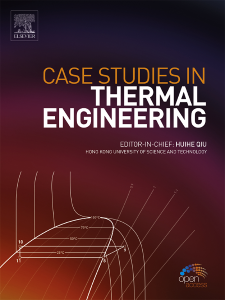Thermal performance of shell-and-tube polymeric hollow fiber heat exchangers as oil coolers
IF 6.4
2区 工程技术
Q1 THERMODYNAMICS
引用次数: 0
Abstract
Motor oil must be appropriately treated in motors, and aluminum plate heat exchangers are used to cool it. An aluminum heat exchanger is an additional part of the oil treatment module, which increases its size and weight. Two compact plastic shell-and-tube heat exchangers were tested alongside with aluminum heat exchanger to evaluate the efficiency of the plastic cooling core inside the oil module. A total of 63 experimental points were tested on three heat exchangers with good thermal balance (discrepancy of about 1,8 %), and the data were used to evaluate the heat transfer coefficients. While plastic unit PA11 showed the heat outputs exceeding the heat output of the aluminum plate unit by about 7 %, the pressure drops were about ten times higher. The unit PEEK showed good performance and pressure drops on the oil side, but the heat transfer was limited by a small heat transfer surface. Analysis of thermal resistances confirmed that the thermal resistance between the wall and the oil is dominant due to the oil's low thermal conductivity and high viscosity. The results showed that optimization of the fiber structures is needed, aiming to increase the oil flow around the fiber structures.
壳管式聚合物中空纤维热交换器作为油冷却器的热性能
电机中的机油必须经过适当处理,铝板热交换器用于冷却机油。铝热交换器是油处理模块的一个额外部件,会增加模块的尺寸和重量。为了评估油模块内塑料冷却核心的效率,我们同时测试了两个紧凑型塑料壳管式热交换器和铝热交换器。在热平衡良好(差异约为 1.8%)的三个热交换器上共测试了 63 个实验点,并利用这些数据评估了传热系数。塑料装置 PA11 的热量输出比铝板装置的热量输出高出约 7%,但压降却高出约 10 倍。PEEK 单元在油侧表现出良好的性能和压降,但由于传热表面较小,传热受到限制。热阻分析表明,由于油的导热率低、粘度高,壁和油之间的热阻占主导地位。结果表明,需要对纤维结构进行优化,以增加纤维结构周围的油流。
本文章由计算机程序翻译,如有差异,请以英文原文为准。
求助全文
约1分钟内获得全文
求助全文
来源期刊

Case Studies in Thermal Engineering
Chemical Engineering-Fluid Flow and Transfer Processes
CiteScore
8.60
自引率
11.80%
发文量
812
审稿时长
76 days
期刊介绍:
Case Studies in Thermal Engineering provides a forum for the rapid publication of short, structured Case Studies in Thermal Engineering and related Short Communications. It provides an essential compendium of case studies for researchers and practitioners in the field of thermal engineering and others who are interested in aspects of thermal engineering cases that could affect other engineering processes. The journal not only publishes new and novel case studies, but also provides a forum for the publication of high quality descriptions of classic thermal engineering problems. The scope of the journal includes case studies of thermal engineering problems in components, devices and systems using existing experimental and numerical techniques in the areas of mechanical, aerospace, chemical, medical, thermal management for electronics, heat exchangers, regeneration, solar thermal energy, thermal storage, building energy conservation, and power generation. Case studies of thermal problems in other areas will also be considered.
 求助内容:
求助内容: 应助结果提醒方式:
应助结果提醒方式:


